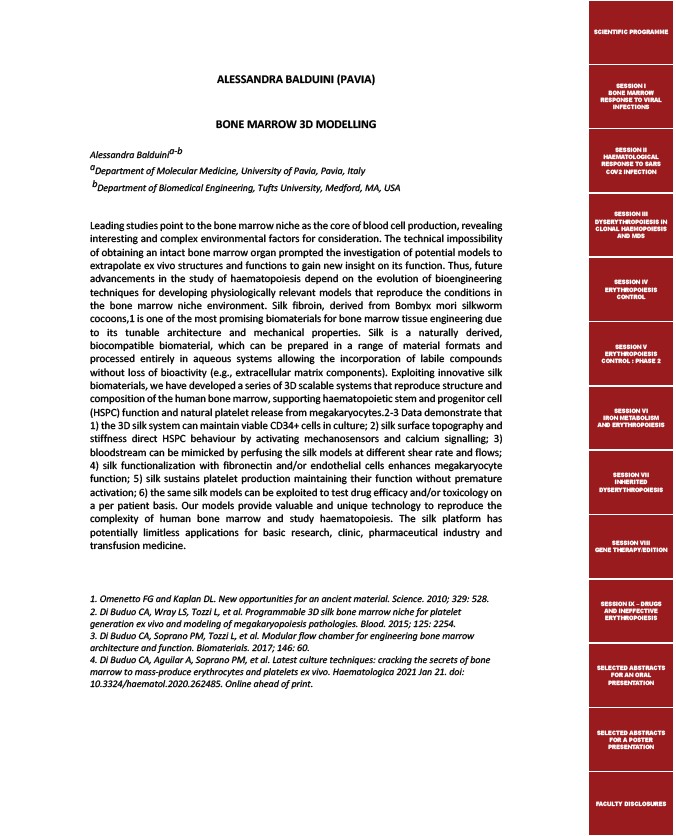
ALESSANDRA BALDUINI (PAVIA)
BONE MARROW 3D MODELLING
Alessandra Balduinia-b
aDepartment of Molecular Medicine, University of Pavia, Pavia, Italy
bDepartment of Biomedical Engineering, Tufts University, Medford, MA, USA
Leading studies point to the bone marrow niche as the core of blood cell production, revealing
interesting and complex environmental factors for consideration. The technical impossibility
of obtaining an intact bone marrow organ prompted the investigation of potential models to
extrapolate ex vivo structures and functions to gain new insight on its function. Thus, future
advancements in the study of haematopoiesis depend on the evolution of bioengineering
techniques for developing physiologically relevant models that reproduce the conditions in
the bone marrow niche environment. Silk fibroin, derived from Bombyx mori silkworm
cocoons,1 is one of the most promising biomaterials for bone marrow tissue engineering due
to its tunable architecture and mechanical properties. Silk is a naturally derived,
biocompatible biomaterial, which can be prepared in a range of material formats and
processed entirely in aqueous systems allowing the incorporation of labile compounds
without loss of bioactivity (e.g., extracellular matrix components). Exploiting innovative silk
biomaterials, we have developed a series of 3D scalable systems that reproduce structure and
composition of the human bone marrow, supporting haematopoietic stem and progenitor cell
(HSPC) function and natural platelet release from megakaryocytes.2-3 Data demonstrate that
1) the 3D silk system can maintain viable CD34+ cells in culture; 2) silk surface topography and
stiffness direct HSPC behaviour by activating mechanosensors and calcium signalling; 3)
bloodstream can be mimicked by perfusing the silk models at different shear rate and flows;
4) silk functionalization with fibronectin and/or endothelial cells enhances megakaryocyte
function; 5) silk sustains platelet production maintaining their function without premature
activation; 6) the same silk models can be exploited to test drug efficacy and/or toxicology on
a per patient basis. Our models provide valuable and unique technology to reproduce the
complexity of human bone marrow and study haematopoiesis. The silk platform has
potentially limitless applications for basic research, clinic, pharmaceutical industry and
transfusion medicine.
1. Omenetto FG and Kaplan DL. New opportunities for an ancient material. Science. 2010; 329: 528.
2. Di Buduo CA, Wray LS, Tozzi L, et al. Programmable 3D silk bone marrow niche for platelet
generation ex vivo and modeling of megakaryopoiesis pathologies. Blood. 2015; 125: 2254.
3. Di Buduo CA, Soprano PM, Tozzi L, et al. Modular flow chamber for engineering bone marrow
architecture and function. Biomaterials. 2017; 146: 60.
4. Di Buduo CA, Aguilar A, Soprano PM, et al. Latest culture techniques: cracking the secrets of bone
marrow to mass-produce erythrocytes and platelets ex vivo. Haematologica 2021 Jan 21. doi:
10.3324/haematol.2020.262485. Online ahead of print.
SCIENTIFIC PROGRAMME
SESSION I
BONE MARROW
RESPONSE TO VIRAL
INFECTIONS
SESSION II
HAEMATOLOGICAL
RESPONSE TO SARS
COV2 INFECTION
SESSION III
DYSERYTHROPOIESIS IN
CLONAL HAEMOPOIESIS
AND MDS
SESSION IV
ERYTHROPOIESIS
CONTROL
SESSION V
ERYTHROPOIESIS
CONTROL : PHASE 2
SESSION VI
IRON METABOLISM
AND ERYTHROPOIESIS
SESSION VII
INHERITED
DYSERYTHROPOIESIS
SESSION VIII
GENE THERAPY/EDITION
SESSION IX – DRUGS
AND INEFFECTIVE
ERYTHROPOIESIS
SELECTED ABSTRACTS
FOR AN ORAL
PRESENTATION
SELECTED ABSTRACTS
FOR A POSTER
PRESENTATION
FACULTY DISCLOSURES